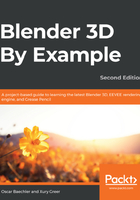
Linking in canned assets
We'll finish the kitchen by linking or appending from a library of canned assets. When deadlines strike, seasoned artists throw three-dimensional scenes together from other resources that can be found or purchased on other websites. You'll also find that curiosity about other peoples' models can teach you about their workflows. We'll round out the last elements of the kitchen by looking at some pre-made assets and appending or linking them to the kitchen, as well.
Let's start by touring the pre-made assets file and see what we can learn from some of the example models. Open up ch05_cannedAssets.blend to get started. Here are some general explanations for the canned assets provided:
- The scene is organized into collections. Some of these collections (fridge, dishwasher, stove, mirror, sideTable, and stoveCounters) hold a single complex thing made of many objects.
- Inside the fridge collection is a hidden collection called fridge junk. This contains Boolean brush meshes, which can be moved around to see how they create the final fridge model. There are similar junk collections in the stove and dishwasher collections. Individual beziers on the curve can be thickened or thinned by pressing Alt + S and rotated by pressing Ctrl + T.
- The mirror was made with curve objects. In the Properties window's Geometry tab, these curves were assigned with custom bevel objects. The bevel objects can be found in the junk_mirror layer, as in the following screenshot.
- Some collections include many separate objects, such as the dishes, food, and lights layers:

At this point, you have all the skills required to append or link these files to your kitchen scene. How you choose to use them for decorating is up to you. Here are some tips we recommend while appending them:
- Use the Array modifiers on these models frequently. The Array modifiers can stack plates high, repeat light fixtures every 6 feet, and lights can be repeated.
- While you might append the whole collection for something such as the fridge, in other cases, such as the wine bottle, you might append just a single model.
- When first bringing assets over, double-check the scale. For instance, the mirror is too big.
- Complex hierarchies such as the fridge can be difficult to position without breaking the Boolean placement and work best at the origin. If you're appending, I recommend appending the collection, then adding a collection instance while hiding the original collection. The instance can then be moved, scaled, and rotated without breaking.
- When placing things such as goblets on a shelf, use vertex snapping and grid snapping.
Don't forget to add some food to the kitchen. Look around the canned assets for things such as these:

Wonderful—placing in a bunch of pre-made assets can really bring the scene to life. Don't feel guilty about using pre-made models; if the project is focused on composition, then nobody will criticize you for borrowing assets.
That concludes the modeling phase of our kitchen project. There's more to do before the scene is complete, but we've made it past the composition phase.